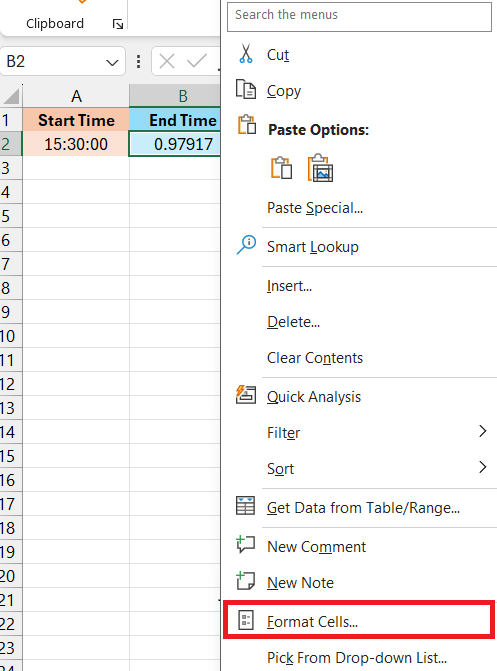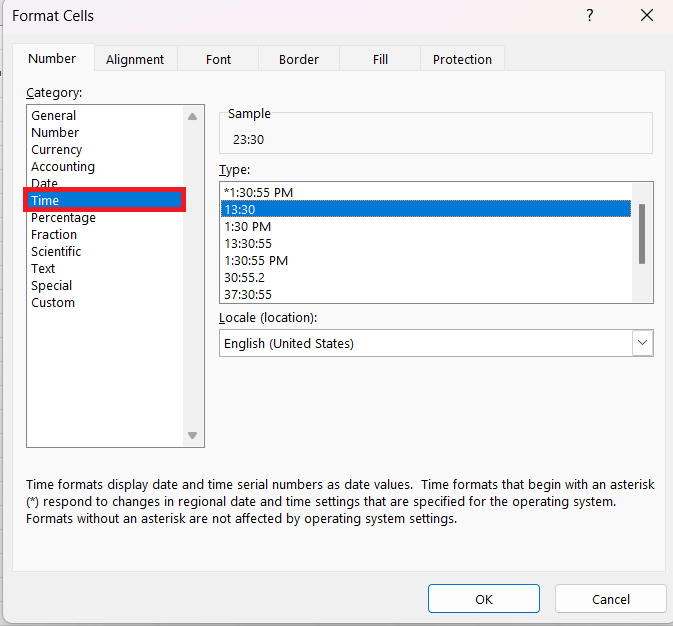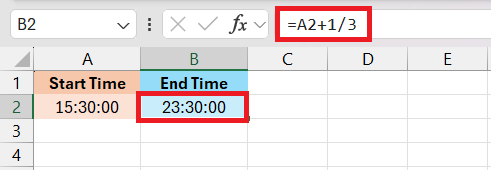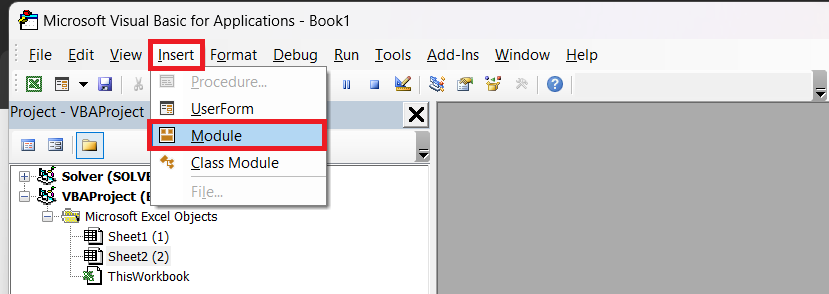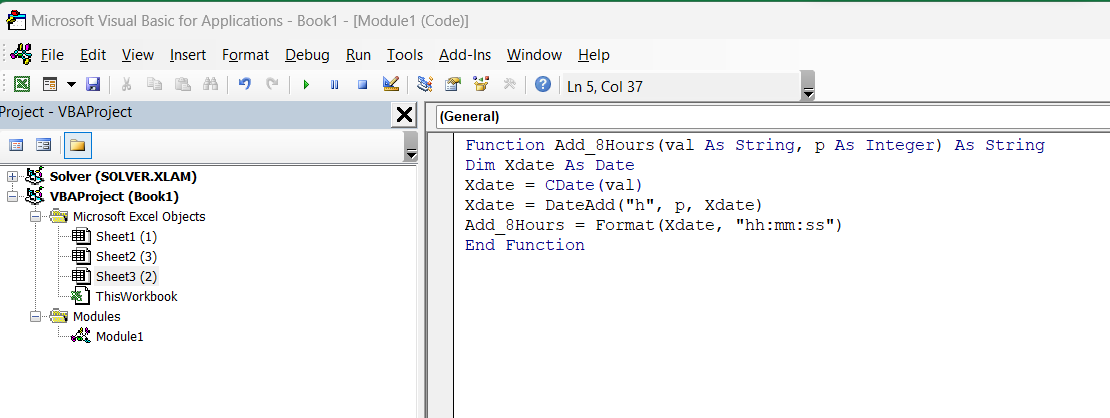Adding 8 hours from now in Microsoft Excel can be a useful skill for various applications, such as tracking work hours or scheduling. In this guide, we’ll explore several straightforward techniques to accurately calculate and display a time that is 8 hours ahead of a given time, enabling efficient time management and planning in your Excel worksheets.
Key Takeaways
- To add 8 hours to a time in Excel, divide the hour value (8) by 24 and add the result to the original time cell.
- Utilize the TIME function by entering `=D5+TIME(8,0,0)` in a cell to add 8 complete hours to the time in cell D5 and press ENTER.
- Drag the fill handle down to apply the formula to additional cells, efficiently replicating the 8-hour addition to multiple times.
- To automate the process to add 8 hours, you can use VBA code.
Download the Excel Workbook and follow along the tutorial on How to Add 8 hours from now in Excel – download excel workbookTIME-Function-in-Excel.xlsm
Table of Contents
Introduction to Mastering Time in Excel
The Importance of Time Calculation in Excel
Time calculation in Excel is essential for a wide range of professionals from project managers to financial analysts. Accurate time management helps in planning tasks, evaluating project timelines, tracking work hours, and calculating deadlines or due dates. The ability to manipulate and compute time effectively in Excel can streamline these processes and enable better decision-making.
How Excel Treats Hours, Minutes, and Seconds
Excel breaks down time into its fundamental components: hours, minutes, and seconds, which are essentially treated as fractions of a day. In Excel’s system, one day is equivalent to the number 1, which means:
- 1 hour is calculated as 1/24 (approximately 0.04167)
- 1 minute is 1/(24*60) (approximately 0.000694)
- 1 second is 1/(24*60*60) (approximately 0.00001157)
When you input a time value, such as 15:30:00 (or 3:30 PM), Excel converts this into a decimal representing the portion of the day that has elapsed. In this case, 15.5 hours have passed, which translates into the numeric time of approximately 0.64583.
This understanding is crucial when performing operations such as adding 8 hours to an existing time value, which is the equivalent of adding the fraction 8/24, or approximately 0.33333, to the serial number representing that time.
Step-by-Step Guide to Adding 8 Hours to a Timestamp
Method 1: Manually Add 8 Hours Using Simple Math
When it comes to manually adding 8 hours to a given timestamp in Excel, you can use straightforward arithmetic. Since Excel treats one hour as 1/24 of a day, you can represent 8 hours as the fraction 8/24, or simply 1/3.
Here’s how to do it in a step-by-step process to add 8 hours from now in Excel –
STEP 1: Let’s say you want current time mentioned in cell A2. You can get that by using the NOW function by entering =NOW().
STEP 2: In the adjacent cell, B2, enter the formula =A2 + 1/3.
STEP 3: Press Enter. Excel will add 8 hours to the time in A2 and display the result in B2.
This method is quick and easy, especially for simple ad-hoc time additions. However, it’s important to remember to format the cells correctly to display the time values as desired. If the cell isn’t already formatted to show times, you can change the format by:
STEP 4: Right-clicking on the cell B2 and choose ‘Format Cells’ from the context menu.
STEP 5: Selecting ‘Time’ from the Category list.
STEP 6: Choosing your preferred time format and clicking OK.
By following these steps, Excel will correctly show the new time which is 8 hours later than the original timestamp in A2.
Method 2: Use the TIME Function for Precision Addition
Using the TIME function for precise addition is a more formal method in Excel for manipulating time values. The TIME function is designed to convert hours, minutes, and seconds into a decimal that represents a specific time of day. To add 8 hours to an existing time using the TIME function, follow these steps:
STEP 1: Assume that the current time value is in cell A2.
STEP 2: To add 8 hours to the time in cell A2, enter the following formula into cell B2: =A2 + TIME(8,0,0) where 8 represents the hours, and both 0 stands for minutes and seconds, respectively.
STEP 3: Press Enter, and Excel will display the new time, 8 hours added to the time in A2, in cell B2.
Using the TIME function can be particularly beneficial when you need to add a specific number of hours, minutes, and seconds to a time. It keeps the formula intuitive and readable, which is helpful for later review or for use by others. For instance, if you wanted to add 8 hours and 15 minutes, the formula would be =A2 + TIME(8,15,0).
By using the TIME function, you can be confident in the precision of your time calculations as Excel interprets your inputs as directed amounts of time, removing the risk of any potential miscalculation that could occur from manually typing fractions into your formulas.
Method 3: Use VBA code for automation
Using Visual Basic for Applications (VBA), a powerful feature in Excel, you can automate repetitive tasks like adding 8 hours from now. VBA is particularly useful when you need to perform this task frequently or on a large dataset.
Here’s a sample VBA code to create a custom function that adds 8 hours to a given time:
Function Add_8Hours(val As String, p As Integer) As String
Dim Xdate As Date
Xdate = CDate(val)
Xdate = DateAdd("h", p, Xdate)
Add_8Hours = Format(Xdate, "hh:mm:ss")
End Function
To use this code in Excel:
STEP 1: Press Alt + F11 to open the VBA editor.
STEP 2: Go to the Insert tab, and select Module to create a new module.
STEP 3: Paste the code provided above into the module.
STEP 4: Close the VBA editor.
You now have a custom function named Add_8Hours that you can use directly in Excel as a formula. To add 8 hours to a time in a specific cell, follow these steps:
STEP 5: Click in the cell where you want to display the result, say cell B2.
STEP 6: Enter =Add_8Hours(A2, 8) in B2, where A2 contains the original time value.
STEP 7: Press Enter, and 8 hours will be added to the time in A2.
This custom function uses the DateAdd method to add a specified number of hours (in this case, 8) to a date. The CDate function ensures that the input value is properly treated as a date. Finally, the Format function converts the result to a readable text string displaying date and time.
Using VBA for such tasks is advantageous because:
- It saves time for large spreadsheets.
- It reduces the likelihood of manual errors.
- It allows for more complex calculations and conditions within the custom function.
When using VBA, always remember to save your workbook as an .xlsm (macro-enabled workbook) file to preserve your code andfunctionality.
FAQ: Frequently Asked Questions
How do you add 8 hours to a time in Excel?
To add 8 hours to a time in Excel, use the formula: =A1 + TIME(8,0,0), assuming the original time is in cell A1.
How do I add 8 hours from now in Excel?
To add 8 hours from now in Excel, use the formula: =NOW() – TIME(8,0,0).
How do you handle daylight saving time changes in Excel?
Handling daylight saving time (DST) changes in Excel requires a bit of manual intervention because Excel doesn’t automatically adjust for changes in local DST. Here are some steps and methods to help you manage DST changes.
- For example, to adjust for spring forward, subtract 1 hour:
=A1 - TIME(1,0,0). - To adjust for fall back, add 1 hour:
=A1 + TIME(1,0,0).
Can you add more than 24 hours to a time value in Excel?
Yes, you can add more than 24 hours to a time value in Excel. The program can handle calculations that extend beyond a single day, which is quite useful for tracking durations in scenarios like long shift hours or multi-day events. Use a straightforward addition formula: =A1 + (hours/24), where hours is the total number of hours you want to add.
John Michaloudis is a former accountant and finance analyst at General Electric, a Microsoft MVP since 2020, an Amazon #1 bestselling author of 4 Microsoft Excel books and teacher of Microsoft Excel & Office over at his flagship MyExcelOnline Academy Online Course.




